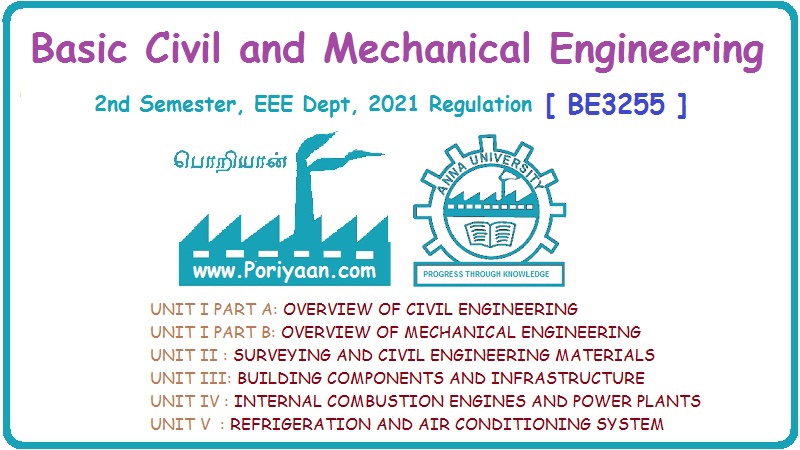Basic Civil & Mechanical Engineering: UNIT IV: b. Boilers
Boilers
Definition, Uses, Requirements, Types
Boiler is also known as Steam Generator. It is a closed metallic vessel. In the boiler, water is converted into steam above atmospheric pressure by the application of heat. Fossil fuels are the source of heat energy.
UNIT – IV
Chapter - 12
BOILERS
BOILERS
Boiler
is also known as Steam Generator. It is a closed
metallic vessel. In the boiler, water is converted into steam above atmospheric
pressure by the application of heat. Fossil fuels are the source of heat
energy.
Uses:
The high pressure steam is used for driving prime movers like steam engines or
steam turbines for power generation. It is also used for producing process
steam in textile industries for bleaching, etc., or in other industries like
paper, sugar, pharmaceutical and chemical industries.
Requirements
of a Boiler
The
primary requirements of a boiler are as follows:
1.
Steam must be delivered at the required temperature, pressure and at the
required rate.
2.
Maximum heat produced by the fuel in the furnace should be utilized for
economy.
3.
The boiler should be easily accessible for maintenance and inspection.
4.
It should rapidly meet the changes in load.
1. TYPES OF BOILERS
Boilers
can be classified as follows:
1.
According to the Flow of Water and Hot Gases
(i)
Fire Tube (or Smoke Tube) Boiler: In Fire Tube Boilers,
hot gases pass through tubes which are surrounded with water. Examples:
Cochran, Lancashire and Locomotive boilers. There may be single tube as in the
case of Lancashire boiler or there may be a bank of tubes as in a Locomotive
boiler.
(ii)
Water Tube Boiler: In Water Tube Boilers, water
circulates through a large number of tubes and hot gases pass around them. Example:
Babcock and Wilcox Boiler.
2.
According to the Axis of the Shell
(i)
Vertical Boiler: The axis of the shell is vertical. Example:
Cochran Boiler.
(ii)
Horizontal Boilers: The axis of the shell is
horizontal.
Examples:
Locomotive Boiler and Lancashire Boiler
3.
According to the Application
(i)
Stationary Boiler: A Stationary Boiler is one which
is installed permanently on a land installation. Examples: Cochran, etc.
(ii)
Mobile Boiler: A Marine Boiler is a mobile boiler meant
for ocean cargo and passenger ships with an inherent fast steaming capacity.
4.
According to the Steam Pressure Developed
(i)
Low Pressure Boilers: The pressure of steam produced is
less than 80 bar.
Examples:
Cochran and Lancashire Boilers.
(ii)
High Pressure Boilers: The pressure of steam produced is
more than 80 bar.
Examples:
Babcock Boiler, Wilcox Boilers, La-Mont Boiler and Benson Boiler.
5.
According to the Location (Position) of the Furnace or Method of Firing
(i)
Internally Fired Boilers: In internally fired
boilers, the furnace forms an integral part of the boiler structure. Examples:
Lancashire, Locomotive and Scotch Marine Boilers.
(ii)
Externally Fired Boilers: Externally fired
boilers have a separate furnace built outside the boiler shell and usually
below it. Examples: Babcock Boiler and Wilcox Boiler.
6.
According to the Method of Water Circulation
(i)
Natural Circulation Boilers: The water is
circulated by natural convection currents caused by the temperature difference.
Example: Lancashire Boiler.
(ii)
Forced Circulation Boilers: The water is
circulated by a pump driven by a motor.
Examples:
La-Mont Boiler and Velox Boiler.
2. LOW PRESSURE BOILERS
The
boilers producing steam at a pressure of less than 80 bar are known as Low
Pressure Boilers. Fire Tube Boilers are preferred for low pressure steam
generation.
Basic Civil & Mechanical Engineering: UNIT IV: b. Boilers : Tag: : Definition, Uses, Requirements, Types - Boilers
Related Topics
Related Subjects
Basic Civil and Mechanical Engineering
BE3255 2nd Semester 2021 Regulation | 2nd Semester EEE Dept 2021 Regulation
